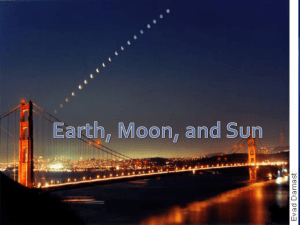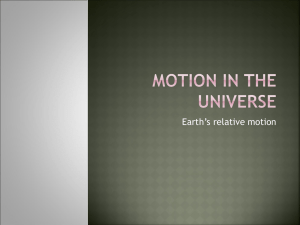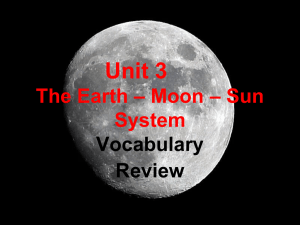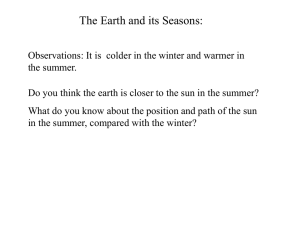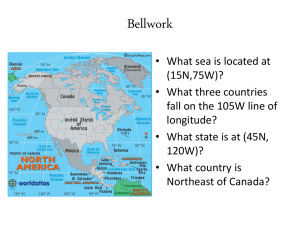KEY – Study Guide - Chapter 19.1: Earth in Space Key Terms
advertisement
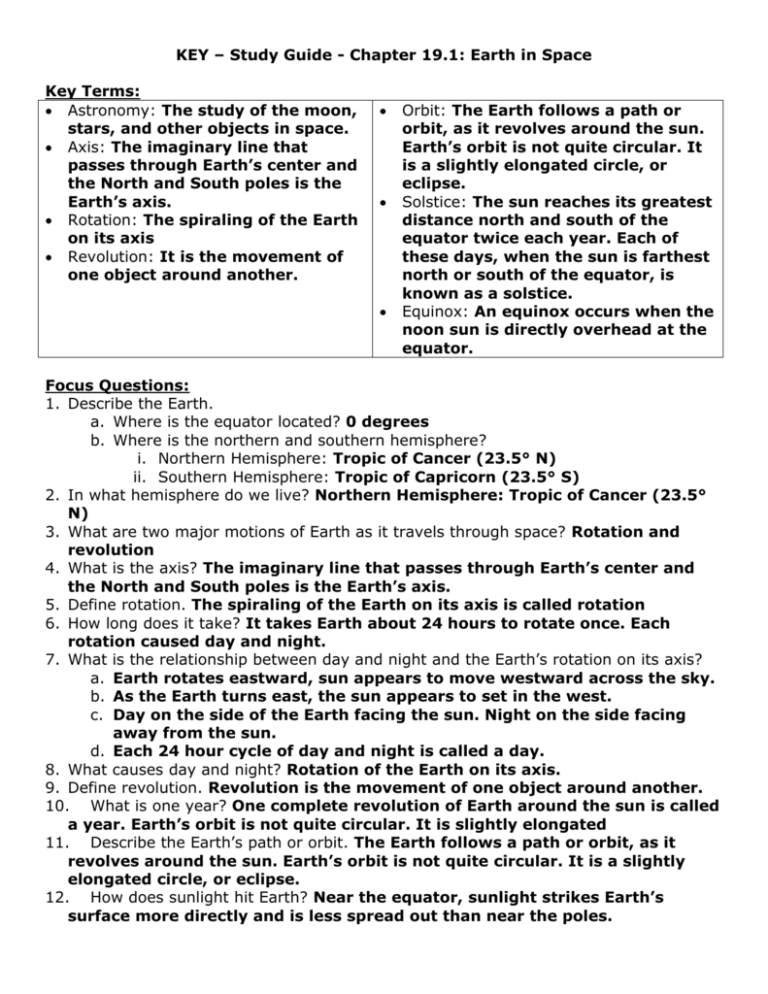
KEY – Study Guide - Chapter 19.1: Earth in Space Key Terms: Astronomy: The study of the moon, stars, and other objects in space. Axis: The imaginary line that passes through Earth’s center and the North and South poles is the Earth’s axis. Rotation: The spiraling of the Earth on its axis Revolution: It is the movement of one object around another. Orbit: The Earth follows a path or orbit, as it revolves around the sun. Earth’s orbit is not quite circular. It is a slightly elongated circle, or eclipse. Solstice: The sun reaches its greatest distance north and south of the equator twice each year. Each of these days, when the sun is farthest north or south of the equator, is known as a solstice. Equinox: An equinox occurs when the noon sun is directly overhead at the equator. Focus Questions: 1. Describe the Earth. a. Where is the equator located? 0 degrees b. Where is the northern and southern hemisphere? i. Northern Hemisphere: Tropic of Cancer (23.5° N) ii. Southern Hemisphere: Tropic of Capricorn (23.5° S) 2. In what hemisphere do we live? Northern Hemisphere: Tropic of Cancer (23.5° N) 3. What are two major motions of Earth as it travels through space? Rotation and revolution 4. What is the axis? The imaginary line that passes through Earth’s center and the North and South poles is the Earth’s axis. 5. Define rotation. The spiraling of the Earth on its axis is called rotation 6. How long does it take? It takes Earth about 24 hours to rotate once. Each rotation caused day and night. 7. What is the relationship between day and night and the Earth’s rotation on its axis? a. Earth rotates eastward, sun appears to move westward across the sky. b. As the Earth turns east, the sun appears to set in the west. c. Day on the side of the Earth facing the sun. Night on the side facing away from the sun. d. Each 24 hour cycle of day and night is called a day. 8. What causes day and night? Rotation of the Earth on its axis. 9. Define revolution. Revolution is the movement of one object around another. 10. What is one year? One complete revolution of Earth around the sun is called a year. Earth’s orbit is not quite circular. It is slightly elongated 11. Describe the Earth’s path or orbit. The Earth follows a path or orbit, as it revolves around the sun. Earth’s orbit is not quite circular. It is a slightly elongated circle, or eclipse. 12. How does sunlight hit Earth? Near the equator, sunlight strikes Earth’s surface more directly and is less spread out than near the poles. 13. What is the relationship between the Earth’s tilted axis and seasons? Earth has seasons because its axis is tilted as it revolves around the sun. 14. What is the tilt of the Earth’s axis? The Earth’s axis is always tilted at an angle of 23.5° from the vertical. The north end of its axis is tilted away from the sun for part of the year and toward the sun for part of the year. 15. What causes summer and winter? Summer and winter are caused by Earth’s tilt as it revolves around the sun. 16. When is the Earth farthest from the sun? The Earth is farthest from the sun when it is in summer in the Northern Hemisphere. (The seasons are not caused the Earth’s distance from the sun.) 17. Describe the Earth in June. a. Tilt of the axis: The north end of the Earth’s axis is tilted toward the sun. b. Sun’s position and hours of daylight: In the Northern Hemisphere, the noon sun is high in the sky and there are more hours of daylight than darkness. There are more direct rays and hours of sunlight than any other time of year. c. Season in the Northern Hemisphere: It is summer in the Northern Hemisphere. 18. Describe the Earth in December. a. What hemisphere is receiving the most direct sunlight? The Southern Hemisphere is receiving the most direct sunlight. b. What season is it in the Southern Hemisphere? Summer 19. What is a solstice? The sun reaches its greatest distance north and south of the equator twice each year. Each of these days, when the sun is farthest north or south of the equator, is known as a solstice. 20. How is the solstice related to seasons and length of day? The day when the sun is farthest north of the equator is the summer solstice in the Northern Hemisphere. It is also winter solstice in the Southern Hemisphere. 21. What days do the solstices occur and what hemispheres are experiencing the longest and shortest days of the year? a. Around June 21st – The day with the sun is the farthest north of the equator is the longest day of the year in the Northern Hemisphere and shortest day in the Southern Hemisphere. b. Around December 21st, the sun is the farthest south of the equator. It is the winter solstice and the shortest day of the year in the Northern Hemisphere and the longest day in the Southern Hemisphere. 22. What is an equinox? Halfway between the solstices, neither hemisphere is tilted toward or away from the sun. This occurs twice a year, when the noon sun is directly overhead at the equator. Each of these days is known as an equinox. 23. What is the length of day and night during an equinox? Equal hours of day and night everywhere on Earth. 24. What dates do an equinox occur? Vernal (spring) equinox occurs around March 21 and autumnal (fall) equinox occurs around September 22. Chapter 19, Section 2 Key Terms: Force Weight Gravity Inertial Law of universal gravitation Newton’s first law of motion Mass Focus Questions 1. What determines the strength of the force of gravity between two objects? Mass and distance. 2. What two factors combine to keep the moon and Earth in orbit? Inertia and Gravity Chapter 19, Section 3 Key Terms Phases Lunar eclipse Eclipse Tide Solar eclipse Spring tide Umbra Neap tide Penumbra Focus Questions 1. What cause the phases of the moon, eclipses, and tides? The changing relative positions of the moon, Earth, and sun cause the phases of the moon, eclipses, and tides. 2. The phase of the moon you see depends on what? The phase of the moon depends on how much of the sunlit side of the moon faces Earth. 3. Be able to identify all phases of the moon and the order in which they appear. 4. Why can you not see the far side of the moon from Earth? Because the moon rotates once for each revolution around the Earth. 5. What causes an eclipse? An eclipse occurs when an object in space comes between the sun and a third object, it casts a shadow on the object. 6. When do solar eclipses occur? (Describe the location of objects in space)During what phase of the moon can a solar eclipse occur? A solar eclipse occurs when the moon passes directly between Earth and the sun, blocking sunlight from Earth. This will occur during a new moon. 7. When do lunar eclipses occur? (Describe the location of objects in space)During what phase of the moon can a lunar eclipse occur? During a lunar eclipse, Earth blocks sunlight from reaching the moon. 8. Why are you less likely to see a total solar eclipse than a total lunar eclipse? Because the moons umbra only covers a small area on Earth’s surface. 9. What is a tide? The rise and fall of ocean water that occurs every 12.5 hours or so. 10. When are tides the highest? When the sun, Earth, and the moon are nearly in a line. 11. What is a spring tide? A tide with the greatest difference between consecutive low and high tides. 12. What is a neap tide? A tide with the least difference between low and high tides.
